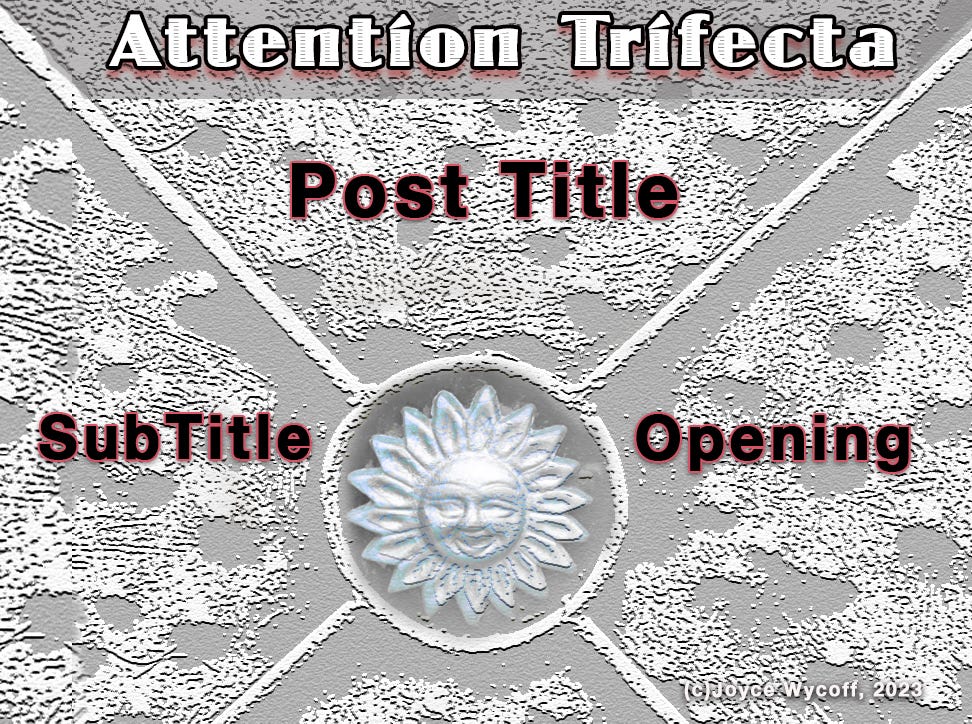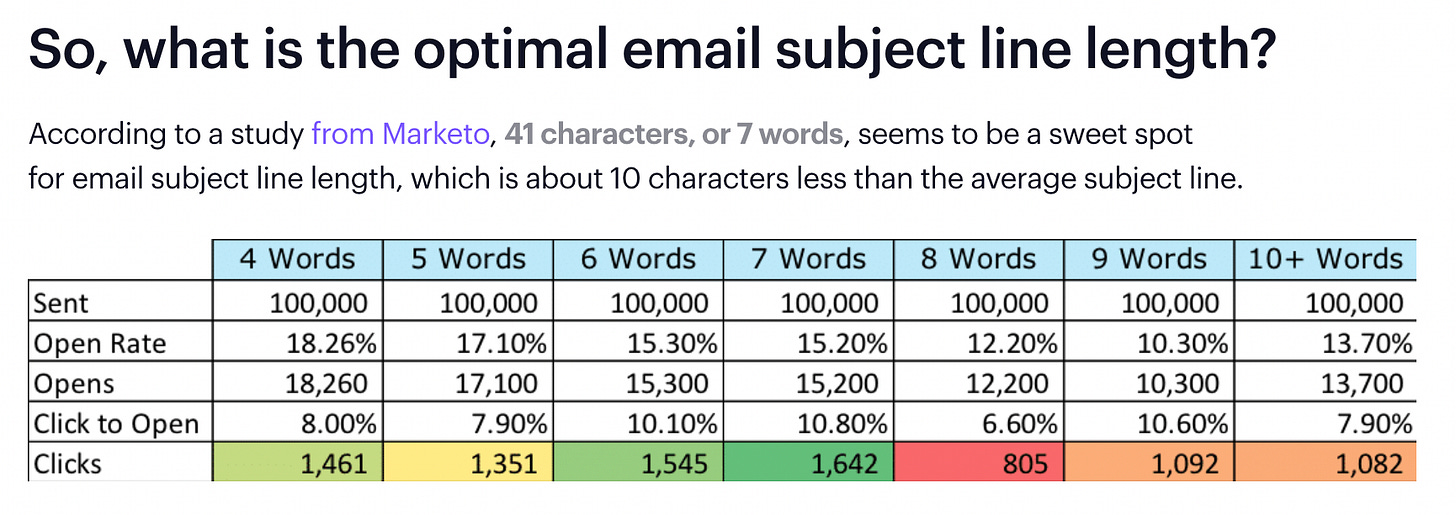Newsletter writing is a tricky balance … it’s personal for both you and your readers. You want to write about what interests you. Readers want to read about what interests them. Sometimes there’s a natural fit and “success” comes easily. (Success defined by each newsletter author, generally some combination of reader engagement and subscriptions.) Sometimes the fit is slim or harder to find and authors may grow frustrated. Being willing to experiment within your own realm of interests and curiosity is key to building a sustainable newsletter over the long run.
Part of that experimentation is learning how to gain reader attention in a world that is already clamoring for their attention. For newsletters, there is a trifecta of three attention getting elements:
Title: … the value hook (visible on email summary … critical to opening)
Subtitle: … the teaser, the WIIFM (visible on email summary … critical to opening)
Opening … the glance, the gotta-read-this
All of these attention gainers deserve your best word smithing … however, what’s even more important is understanding what your customer wants and needs. In the beginning you will be making your best guess at this. Gradually though, as you pay attention to reader engagement (through comments, likes, shares and polls) and watch your views and open rate metrics, you will start to have a feel for which posts really land in that sweet spot of your readers’ attention. Your aim will get better over time.
Warning: I recently discovered that about 80-85% of my opens are in email.
It’s important to preview your posts for email, app and web delivery …
and to review the metrics for each post.
Long titles and subtitles can be effective … however, they could also be too long
and be truncated in ways that reduce their effectiveness.
6 - 7 Word Sweet Spot
While this study relates to commercial newsletters, the indication is that 6 or 7 words is a sweet spot for Post Title length.
So, let’s go back to word smithing with your readers’ wants in mind. As much as possible, each piece of the Attention Trifecta needs to focus on reader value. (This still assumes you are writing what YOU want to write.) Writing attention-grabing openings is easier to say than do, so here are some examples:
Shane O’Mara at Brain Pizza, Brief Description: Explore the mysteries of your brain and the magic of life by Shane O'Mara, Substack Featured Writer, best-selling author, and Professor of Experimental Brain Research. Book: Talking Heads - The New Science of How Conversation Shapes Our Worlds
Recent Title: You may not be interested in change, but change is interested in you
Subtitle: The people who stop you getting things done (part two)
Opening: (Second of a three parter: the people who stop you getting things done)
Last time, I discussed some of Mancur Olson’s ideas about distributional and blocking coalitions. In this piece, I want to focus more on why these coalitions arise - in …
So much is good about this trifecta … the title is intriguing and uses the magic word YOU. It revolves around a problem … working with other people. The opening lines reorient the reader as to where they are on this post series and what was being talked about last time. By using links, Shane has used color to emphasize points.
Marisol Trowbridge at The Messy Human Brief Description: Gentle personal growth for overworked achievers, delivered weekly in a reader supported newsletter. Each Tuesday, I share purposeful practices, revealing research, and relatable reflections on living whole, raw, and real.
Recent Title: Joy in Imperfection: Normalize Being Human
Subtitle: Discover the joy that resides in your own unique flaws... but wait, is that a good idea?
Opening: In a world where perfection is often celebrated and sought after, embracing imperfection may seem counterintuitive. We are bombarded with images of flawless beauty, success stories devoid of struggle, and the constant pursuit of an idealized version of ourselves.
Marisol’s title and subtitle focus on a reader value and set up a conversation between author and reader in the subtitle. “but wait” is a powerful thought starter which is then expanded in the opening that invites counterintuitive thinking. She aligns with the reader saying, “We are bombarded …. “ Early on in the post, there is a subhead: The Imperfection Paradox to further intrigue the reader.
Edwin Kiptoo Ngetich at The STARTUP from AFRICA, Brief Description: Know the nexus between technology and African people. Africa and the Rest of the World. Social. Local culture. Economy. History. Politics Underserved Communities Building the future
Recent Title: I finally found real humans on the internet
Subtitle: At Substack, the internet is getting better and better with heart-to-heart conversations
Opening: Amid the massive algorithmazation of the internet, we are lucky, at least here on Substack, to meet and hear the voices of the real human beings.
I admit to being partial to Edwin. He wrote a guest post for gratitude mojo community that affected me deeply. But that didn’t earn him his place on this listing … his use of the Attention Trifecta did. He connects with something we all have experience with and tells two stories that confirm the premise in his title and subtitle. In his opening, he brings the reader into the issue and uses a clever word that I understood immediately even though I had never actually heard it before … “algorithmazation.”
Priya Joi at Science Safari, Brief Description: Science and health stories without the jargon.
Recent title: Is it bad news for science that astrology has become popular again?
Subtitle: From manifesting during a new moon to blaming things on mercury in retrograde, astrology is riding a high in pop culture – but does it affect how people engage with science?
Opening: The first time I saw an astrologer, it was in Bangalore in the 1980s, and my mum, sister and I were crowded into an oppressively stuffy room while a wizened old man pored over charts with symbols and Sanskrit text. Mum was trying to figure out an auspicious time to sell a clothes shop she owned in the city.
The title question appeals to both science folks and astrology interested people and the opening lines tell us that this is a unique approach to the subject and a setting and story that should be interesting.
Additional Resource: Email Opening Lines for Every Marketing Situation
“Every digital marketer knows email titles are crucial. Using killer subject lines is the equivalent of putting your best foot forward.
But what will greet them upon clicking on your emails? Read on to learn how to introduce your marketing messages and how to craft email opening lines for every situation.” — Campaign Monitor





